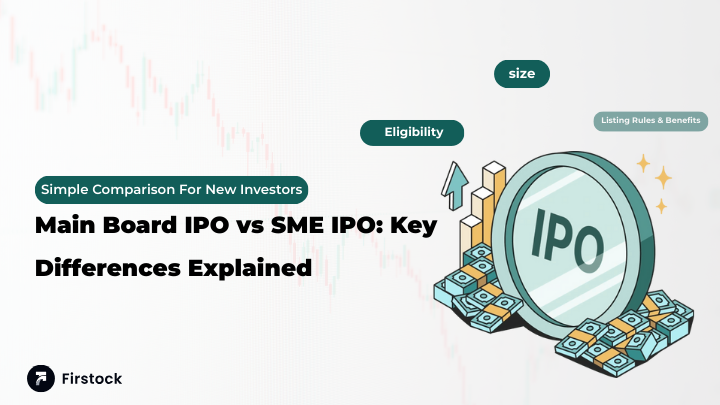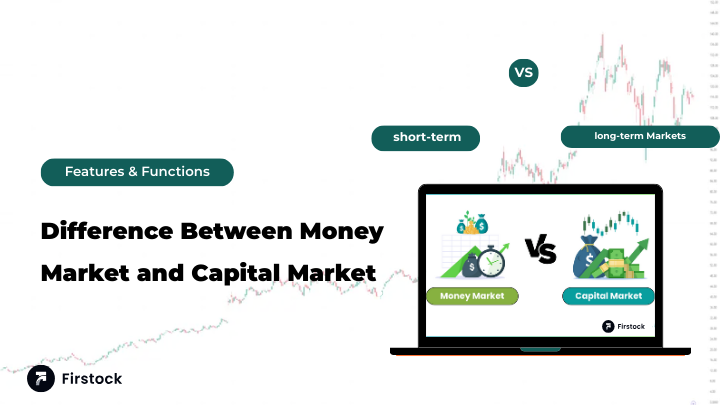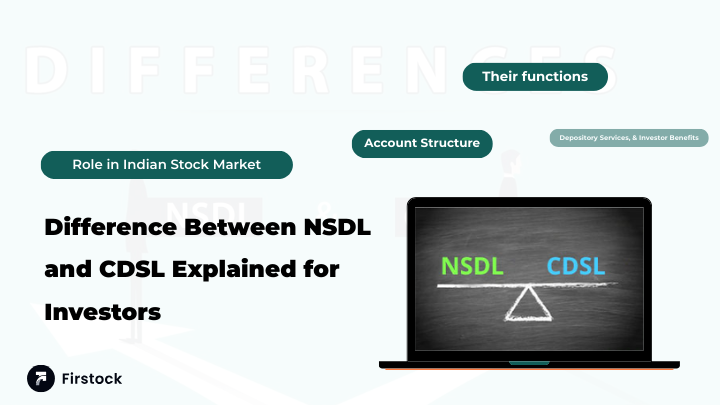Main Board IPO vs SME IPO: Key Differences Explained| 2026

Main Board IPO vs SME IPO: Complete Guide for Beginners
Investing in IPOs has become so popular these days that even first-time investors want to grab a piece of the action. And whenever you check an IPO calendar, you’ll notice two categories staring at you:
👉 Main Board IPO
👉 SME IPO
At first glance, both seem similar—you apply, you wait, and you pray for listing gains. But the truth is, the main board IPO vs SME IPO difference is huge.
To make this super easy to understand, imagine the stock market as a giant airport:
✈ Main Board IPOs are like large international airlines—big fleets, strong credibility, heavy regulation, and global operations.
🛩 SME IPOs are like small regional airlines—flexible, fast-growing, and exciting, but with more bumps on the journey.
In this article, we break everything down in simple, everyday language. No jargon, no complicated financial terms—just clear explanations that even a complete beginner can understand.
Disclaimer: This post is for informational purposes only and does not constitute investment advice. Please consult with a financial advisor before making any investment decisions.
What Is an IPO?
An IPO, or Initial Public Offering, is the event where a private company offers its shares to the public for the very first time. It’s the moment a company says, “From today, anyone can become a shareholder.”
A simple analogy— An IPO is like a family-run restaurant that finally opens to the public, allowing everyone to buy a small ownership slice.
Once a company launches an IPO, its shares get listed on a stock exchange like NSE or BSE.
What Is Main Board IPO?
A Main Board IPO is an IPO launched by a large, well-established company that meets strict regulatory, financial, and operational requirements set by SEBI and stock exchanges.
These companies are listed on:
- NSE Main Board
- BSE Main Board
Key Traits
- Large company size
- Strong financial stability
- Long business track record
- Strict compliance and disclosures
- Higher investor participation
If you hear a buzzing, high-profile IPO in the news, it’s usually a main board IPO.
What Is SME IPO?
A SME IPO is an IPO launched by Small and Medium Enterprises (SMEs) to raise funds for expansion and growth. These companies are listed on:
- NSE Emerge
- BSE SME
Key Traits
- Smaller company size
- Rapid growth potential
- Lower compliance burden
- Higher minimum investment
- Higher business risk
The popularity of SME IPOs has surged because many deliver impressive listing gains.
Main Board IPO vs SME IPO: Quick Comparison
Here is the most simple, clear, and snippet-ready differentiation:
Eligibility Criteria for Main Board IPO
To launch a main board IPO, a company must satisfy:
- Minimum ₹10 crore paid-up capital
- Minimum ₹3+ years’ financial history
- Positive net worth
- Strong governance practices
- Mandatory SEBI & exchange verification
- Verified track record of profits (in most cases)
These rules ensure only credible, stable companies go public on the main board.
Eligibility Criteria for SME IPO
A company qualifies for SME IPO if it has:
- Minimum ₹1 crore paid-up capital
- At least 1–2 years of operations
- Simplified documentation
- Merchant banker evaluation
- Audited financial statements
Regulation is lighter because SMEs are still growing.
What Is Main Board IPO GMP?
Main Board IPO GMP refers to the Grey Market Premium—the informal market price at which IPO shares trade before official listing.
For example: If an IPO is priced at ₹400 and the GMP is +₹70, the estimated listing price may be around ₹470.
Why GMP Matters
- Shows investor demand
- Indicates listing prediction
- Helps gauge market sentiment
But GMP is not official and can change rapidly.
Why Companies Choose Main Board IPO
Large companies select main board IPOs because they offer:
- Huge fundraising capability
- Wider investor trust
- Global brand recognition
- Better liquidity in the market
- Entry into major stock indices
It’s similar to moving from a regional league to the IPL—big exposure, big expectations.
Why Growing Businesses Prefer SME IPO
SME IPOs are ideal for companies that:
- Need quick capital
- Are expanding rapidly
- Want flexible regulatory requirements
- Cannot meet main board IPO compliance yet
For many startups, SME listing is the first milestone before reaching the main board.
Advantages of Investing in Main Board IPO
✔ Lower risk
Main board companies are financially strong and well-regulated.
✔ High liquidity
You can easily buy or sell shares anytime.
✔ Strong brand reputation
Investing in well-known companies feels safer.
✔ Suitable for long-term investors
Stable returns and business continuity.
Advantages of Investing in SME IPO
✔ Very high listing gains
Many SME IPOs deliver 50% to 200% premiums.
✔ Early-stage investment opportunity
You enter before the big players join.
✔ Rapid expansion potential
SMEs can double their business faster than large companies.
Risks in Main Board IPO
Despite being safer, risks exist:
- Overhyped valuations
- Poor listing performance
- Market volatility
- Economic slowdown impact
A famous brand does not guarantee good returns.
Risks in SME IPO
SME IPOs carry significantly higher risk:
- Lower liquidity
- Limited financial history
- High promoter dependency
- Wider price fluctuations
- Lesser institutional participation
Investors must research deeply before entering.
Lot Size and Investment Difference
This is one area most beginners misunderstand.
Main Board IPO
- Lot size: ₹10,000 – ₹15,000
- Easy for all investors
- Lower capital requirement
SME IPO
- Lot size: ₹1,50,000 – ₹2,50,000
- Higher capital needed
- Attracts mainly HNI and serious retail investors
So SME IPOs require bigger commitment.
Which Is Better: Main Board IPO or SME IPO?
There is no universal answer. It depends on who you are as an investor.
Choose Main Board IPO if:
- You want safety
- You prefer stability
- You want smaller investment amounts
Choose SME IPO if:
- You’re comfortable with risk
- You want higher listing gains
- You can invest ₹1–2 lakh per lot
Think of it this way: Main board = steady marathon SME = fast, thrilling sprint
How to Apply for Main Board and SME IPOs
You can apply through:
- UPI
- ASBA (Net banking)
- Trading apps
SME IPO application works the same way—just the lot size differs.
Real-Life Examples
Main Board IPO Examples
- Tata Technologies
- LIC
- Zomato
- Nykaa
- Paytm
SME IPO Examples
- Vivaa Tradecom
- Srivari Spices
- Rishabh Instruments (previous SME)
- Ksolves (multi-bagger)
These examples show how SMEs can become tomorrow’s big stars.
Investor Mistakes to Avoid
- Blindly following GMP
- Applying just for hype
- Ignoring lot size cost
- Not studying financials
- Overinvesting in SME IPOs
Smart investing is about balance, not excitement.
Expert Guide for Selecting IPOs
- Check company fundamentals
- Read RHP (Red Herring Prospectus)
- Compare valuations
- Look at promoter history
- Track main board IPO GMP or SME GMP
- Avoid borrowing money for IPOs
- Don’t apply for every SME IPO
Final Conclusion
Both main board IPO and SME IPO come with their own sets of advantages and risks.
- Main board IPO = safer, more stable, lower entry cost
- SME IPO = higher growth, higher returns, higher risk
Your choice should depend on your risk appetite, capital availability, and understanding of the business.
A balanced investor builds a mix of both—stability from main board IPOs and opportunity from SME IPOs.
FAQs
1. What is main board IPO?
A main board IPO is launched by large, stable companies that meet strict SEBI regulations and get listed on NSE or BSE main board.
2. What is SME IPO?
An SME IPO is launched by small and medium enterprises to raise capital and get listed on platforms like NSE Emerge or BSE SME.
3. Is SME IPO riskier than main board IPO?
Yes. SME IPOs involve higher business risk and lower liquidity due to smaller company size.
4. What is main board IPO GMP?
Main board IPO GMP indicates grey market premium—an unofficial value that shows the expected listing price based on investor demand.
5. Which is better: main board IPO or SME IPO?
Main board IPOs are safer, while SME IPOs offer higher growth and higher potential returns but also carry higher risk.





